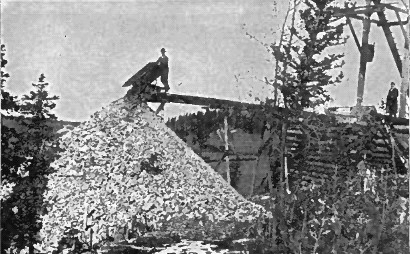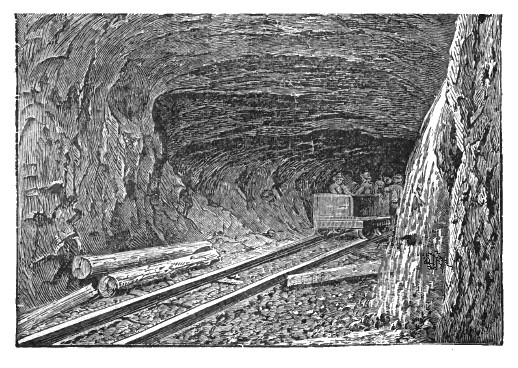Silver ores have been produced from a number of areas across the planet. Historically, these important mining districts were all very important in the economic development development of the world economy, and they are described below. The most important copper mining regions in the US form into five distinct belts: (1) Freiberg, Germany; (2) Clausthal, Germany; (3) Laurium, Greece; (4) Mexico, (5) Broken Hill, Australia and (6) Pribram, Czech Republic. In each of these regions, there are multiple mines that have been important silver producers. While not described in theis document, Peru and Bolivia in South America have also been important producers. The silver ores are found in many geologic formations and the deposits have been formed in many different ways. Here is a description of each of them:
Freiberg, Germany: The Freiberg, Saxony, silver district, now practically closed, possesses an historic interest, because it was here that Werner in 1791 developed his theories regarding fissure veins. The silver-lead deposits of Freiberg comprise a complicated system of fissure veins, of which over 1100 are known. They occur in an arch of biotite gneiss, and are separable into an older and a younger group. The former contains the argentiferous quartz, pyrite, lead, and argentiferous ("noble '') lead formation, being a barite and galena zone. The younger veins are a Barytic lead formation containing barite, fluorite, quartz, calcite, galena (poor in silver), chalcopyrite, tetrahedrite, and sphalerite. These veins are often of considerable width. Geologists have pointed out their probable genetic connection with the intrusive Carboniferous granites of the Erzgebirge and their well-established relationship to the tin veins which are situated closer to or within the intrusives. The Freiberg veins of this type are narrow, being seldom 3 feet wide, and have been mined to a depth of 2,100 feet. The pyrite, arsenopyrite, and sphalerite are poor in silver, but the galena contains 0.1 to 0.2 per cent silver.
Clausthal, Germany: The mines of Clausthal, in the Harz Mountains of Germany, which have been in operation since the thirteenth century and long maintained a moderate production, explore a vein system which intersects a folded complex of Devonian and Carboniferous sedimentary beds, the prevailing rocks being clay slate and graywacke. The general strike of the veins is east-west, and the dip is steep. The numerous veins extend over an area 15 miles in length and 5 miles in width; they are in general composite veins or lodes and occupy fissures or breccia zones. The important fissures are also faults of considerable throw. Mining operations in this district have attained a depth of 3,000 feel.
The ores contain chiefly galena and sphalerite, with some marcasite, pyrite, chalcopyrite, and tetrahedrite. Arsenical minerals are generally absent. In one group of veins calcite and quartz predominate; in another barite and siderite. The galena contains only 0.05 per cent, silver, though richer ores with as much as 0.3 per cent, silver are found in some mines. Symmetrical banding is exceptional, the normal ore having an irregularly massive structure. The tendency appears to be toward an increase in the percentage of zinc in depth. Within the lodes the clay slates are slightly altered by mechanical and chemical processes. The change in composition is slight and appears to consist largely of an increase in sericite at the expense of an original chloritic mineral in the clay slate. Opinions differ as to the genetic interpretation of the veins of Clausthal. There are no intrusive rocks in the immediate vicinity aside from a dike of kersantite, which is faulted by the vein fissures, and the mass of "Brocken" granite in the eastern part of the district. A genetic connection of these intrusives with the veins seems probable, but cannot be regarded as proved. According to von Koenen the fissures are of Miocene age and some movement on these fissures seems to be taking place at present. The mineral association would indicate deposition at less depth or at lower temperature than in the veins of the Coeur d'Alene district, for instance.
Laurium, Greece: is another classic and historic locality deserving mention. The mines were one of the chief sources of revenue of the Athenian state, and were employed for coinage in the ancient world. The deposits consist replacement deposits of silver ores carrying argentiferous galena and sphalerite in crystalline limestone. The mines may have been worked as early as 1000 BC, but in 482 BC, a large new strike was made. Athenians exploited the wealth of the new veins to finance construction of a large fleet, which then defeated the Persians at Salamis in 480. Sparta forced the closing of the mines after their occupation of Decelea in 413 BC. Production remained low until after 350, when, as Demosthenes' speeches show, large fortunes were being made by the proprietors. The Laureot Owls, Athenian silver coinage attributed to the mines, were circulated throughout the classical world. The reliable purity of the silver (which was protected by law) led to Athenian "owls" being widely respected. They have been found as far away as India and Algeria. The design with Athena on obverse and owl with an olive-sprig on reverse was unchanged for centuries. During the height of operations, there were about 350 mines producing 1000 talents a year, worked by 10-20,000 slaves. Mining rights were owned by the city-state of Athens, but leased to individuals by 10 annually elected officers. Ore extraction from very deep vertical mineshafts, off which were narrow and cramped horizontal galleries. Ore separated from waste by gravity methods in special "washeries" (the lead and silver ores being denser (heavier) than the waste rock). The impure silver-lead concentrates were smelted in a furnace or crucible with materials capable of reducing the ore to metals. Factories were designed to minimize risks of slaves getting hold of silver.
However, by Roman times the mines lay neglected because of competition from the gold and silver mines of Pangaeum in Macedonia and piratical raids on the Laurium mines. About the beginning of the Christian Era, the silver was exhausted, and not until after 1860, when franchises were granted to Greek, French, and U.S. companies for reworking the ancient slag heaps - for lead and the extraction of cadmium and manganese - were the mines again active. The best preserved of the ancient shafts and tunnels are found in the Verzeko Valley just west of Laurium, running south from the village of Ayios Konstandinos. Poisonous fumes from the old smelting operations have killed all vegetation around Laurium. The port is linked by railway to Athens. Pop. (1981) 10,124.
Mexico: Among the Mexican silver-lead deposits those of the Sierra Mojada forming replacement deposits in Cretaceous limestone and similar ones of the Santa Eulalia district are also of importance. Mexico contains a number of well-known representatives of the rich silver ore group, located especially in the eastern Sierra Madre, which, though usually occurring in Tertiary eruptives, sometimes cutting sedimentary rocks. Among these localities should be mentioned Parral, Guanajuato, Real del Monte, Zacatecas, and Pachuca. Silver predominates, the ore minerals, including pyargyrite, acanthite, stephanite, and polybasite, accompanied by tetrahedrite, galena, and sphalerite in a gangue chiefly of quartz. The argentite veins have numerous representatives in Mexico, as at Pachuca, Real, del Monte, and Guanajuato. In general they intersect andesitic rocks of supposedly Miocene age but also cut adjacent or underlying Mesozoic sediments.
The rich and long worked veins of Pachuca1 have come into renewed prominence by the successful application of the cyanide process to their ores. A complicated vein system intersects andesite flows covering Cretaceous sediments. The andesite is extensively propylitized and this altered rock also adjoins the veins, near which, however, a silicification is often superimposed upon the chloritization. In places the andesite is entirely silicified. The veins are filled fissures, crustified or brecciated, with quartz, sometimes amethysthine, as the principal constituent of the gangue; there are also rhodochrosite, rhodonite, adularia, and calcite, the last named being the most recent. The ore minerals consist of argentite, stephanite, polybasite, pyrite, galena, and sphalerite. The veins have been followed to a depth of 2,000 feet and here contain argentite, pyrite, and sphalerite. The ores average about 18 ounces of silver to the ton. The oxidation is marked by the zones of the "colorados" and the "negros," the first of which contains limonite with silver haloid salts and the second much manganese. The "negros" are said to contain more native gold than the deeper ores, which are very low in this metal. There are many other old and famous silver-mining districts in Mexico, the veins of which are similar to those of Pachuca. Among them are Guanajuato, Zacatecas, Sombrerete, Fresnillo, Batopilas, and Parral. In many of these districts, however, the veins are contained in Cretaceous or Jurassic slates and sandstones, though, without much doubt, the mineralization is genetically connected with the surrounding igneous rocks. The latter are in some cases of intrusive origin.
Broken Hill, Australia: One of the best-known silver mines in the world is the Broken Hill Lode in western New South Wales. This great lode, discovered in 1883, was first worked for silver, then silver lead, and in recent years, also zinc. The rocks of the region include: (1) pre-Cambrian sediments, chiefly arkoses and sandstones near the lode, all altered to gneisses and schists; (2) amphibolites derived from eruptives; and (3) granite gneisses and pegmatites. Regional metamorphism was accompanied by shearing along the line of the lode, and later injection of pegmatite along the ore zone. There was also developed in the country rock, garnet, gahnite (ZnAl2O4 ), sillimanite, and rhodonite. The ore bodies, which are associated with the shear zone, often form peculiar saddle-shaped masses. A gossan rich in manganese and iron, passes downwards into oxidized minerals such as cerussite, cerargyrite, and some copper, while below this is a coarse-grained mixture of sphalerite and galena, carrying silver, and intergrown with quartz, garnet, feldspar, and rhodonite. Oxidation extends to depths of 500 to 600 feet, and secondary enrichment is well marked. The primary ores average 3 to 14 oz. silver, 14 to 16 per cent lead, and 8 to 18 per cent zinc.
Pribram, Czech Republic: is a classic locality, situated 40 miles south-southwest of Prague, in the "Silurian syncline," well known in the early history of geology. The mines yield argentiferous lead ores. The steeply dipping veins occur in graywackes and clay slates, which have been folded, faulted, and intruded by a diorite stock. There are also a number of diabase dikes, which follow the veins more or less closely. The veins, some of which have been followed to a depth of over 3500 feet, show a variable thickness, some being 25 feet. About forty of these veins have been worked, and they are contained within a narrow area 4 or 5 miles in length. The common ore minerals are galena and sphalerite, with some pyrite and chalcopyrite, in a gangue chiefly of calcite, siderite, and quartz.
Rich silver minerals like argentite and pyrargyrite, as well as native silver, were plentiful in the oxidized zone. This zone of oxidation descends, in spite of a high present water level, to depths of 200 to 900 feet. Where the veins pass from the graywacke into the diorite, they may lose their galena and silver, and take up stibnite. The origin of these vein deposits seems clearly tied to the intrusive diorite and its satellites of diabasic and lamprophyric dikes found in the area.


